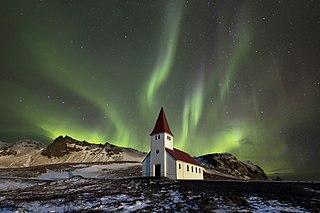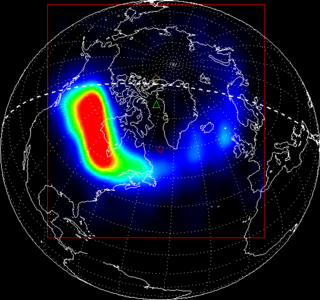Related Research Articles

The ionosphere is the ionized part of the upper atmosphere of Earth, from about 48 km (30 mi) to 965 km (600 mi) above sea level, a region that includes the thermosphere and parts of the mesosphere and exosphere. The ionosphere is ionized by solar radiation. It plays an important role in atmospheric electricity and forms the inner edge of the magnetosphere. It has practical importance because, among other functions, it influences radio propagation to distant places on Earth. It also affects GPS signals that travel through this layer.

An aurora , also commonly known as the northern lights or southern lights, is a natural light display in Earth's sky, predominantly seen in high-latitude regions. Auroras display dynamic patterns of brilliant lights that appear as curtains, rays, spirals, or dynamic flickers covering the entire sky.

A solar flare is a relatively intense, localized emission of electromagnetic radiation in the Sun's atmosphere. Flares occur in active regions and are often, but not always, accompanied by coronal mass ejections, solar particle events, and other eruptive solar phenomena. The occurrence of solar flares varies with the 11-year solar cycle.

Space weather is a branch of space physics and aeronomy, or heliophysics, concerned with the varying conditions within the Solar System and its heliosphere. This includes the effects of the solar wind, especially on the Earth's magnetosphere, ionosphere, thermosphere, and exosphere. Though physically distinct, space weather is analogous to the terrestrial weather of Earth's atmosphere. The term "space weather" was first used in the 1950s and popularized in the 1990s. Later, it prompted research into "space climate", the large-scale and long-term patterns of space weather.
A ring current is an electric current carried by charged particles trapped in a planet's magnetosphere. It is caused by the longitudinal drift of energetic particles.

Earth's magnetic field, also known as the geomagnetic field, is the magnetic field that extends from Earth's interior out into space, where it interacts with the solar wind, a stream of charged particles emanating from the Sun. The magnetic field is generated by electric currents due to the motion of convection currents of a mixture of molten iron and nickel in Earth's outer core: these convection currents are caused by heat escaping from the core, a natural process called a geodynamo.

A geomagnetic storm, also known as a magnetic storm, is temporary disturbance of the Earth's magnetosphere caused by a solar wind shock wave.
There are several conflicting usages of geosphere, variously defined. It may be taken as the collective name for the lithosphere, the hydrosphere, the cryosphere, and the atmosphere. The different collectives of the geosphere are able to exchange different mass and/or energy fluxes. The exchange of these fluxes affects the balance of the different spheres of the geosphere. An example is how the soil acts as a part of the biosphere, while also acting as a source of flux exchange.

Advanced Composition Explorer is a NASA Explorer program satellite and space exploration mission to study matter comprising energetic particles from the solar wind, the interplanetary medium, and other sources.

The International Union of Geodesy and Geophysics is an international non-governmental organization dedicated to the scientific study of Earth and its space environment using geophysical and geodetic techniques.

Ionospheric storms are storms which contain varying densities of energised electrons in the ionosphere as produced from the sun. Ionospheric storms are caused by geomagnetic storms. They are categorised into positive and negative storms, where positive storms have a high density of electrons and negative storms contain a lower density. The total electron content (TEC) is used to measure these densities, and is a key variable used in data to record and compare the intensities of ionospheric storms.

In solar physics, a solar particle event (SPE), also known as a solar energetic particle (SEP) event or solar radiation storm, is a solar phenomenon which occurs when particles emitted by the Sun, mostly protons, become accelerated either in the Sun's atmosphere during a solar flare or in interplanetary space by a coronal mass ejection shock. Other nuclei such as helium and HZE ions may also be accelerated during the event. These particles can penetrate the Earth's magnetic field and cause partial ionization of the ionosphere. Energetic protons are a significant radiation hazard to spacecraft and astronauts.

Global-scale Observations of the Limb and Disk (GOLD) is a heliophysics Mission of Opportunity (MOU) for NASA's Explorers program. Led by Richard Eastes at the Laboratory for Atmospheric and Space Physics, which is located at the University of Colorado Boulder, GOLD's mission is to image the boundary between Earth and space in order to answer questions about the effects of solar and atmospheric variability of Earth's space weather. GOLD was one of 11 proposals selected, of the 42 submitted, for further study in September 2011. On 12 April 2013, NASA announced that GOLD, along with the Ionospheric Connection Explorer (ICON), had been selected for flight in 2017. GOLD, along with its commercial host satellite SES-14, launched on 25 January 2018.

Alexander J. Dessler was an American space scientist known for conceiving the term heliosphere and for founding the first Space Science Department in the United States.

The solar storms of August 1972 were a historically powerful series of solar storms with intense to extreme solar flare, solar particle event, and geomagnetic storm components in early August 1972, during solar cycle 20. The storm caused widespread electric‐ and communication‐grid disturbances through large portions of North America as well as satellite disruptions. On 4 August 1972 the storm caused the accidental detonation of numerous U.S. naval mines near Haiphong, North Vietnam. The coronal mass ejection (CME)'s transit time from the Sun to the Earth is the fastest ever recorded.
Efi Foufoula-Georgiou is a Distinguished Professor in the Civil and Environmental Engineering department at the University of California, Irvine. She is well known for her research on the applications of wavelet analysis in the fields of hydrology and geophysics and her many contributions to academic journals and national committees.

Nancy U. Crooker is an American physicist and professor emerita of space physics at Boston University, Massachusetts. She has made major contributions to the understanding of geomagnetism in the Earth's magnetosphere and the heliosphere, particularly through the study of interplanetary electrons and magnetic reconnection.
Catherine G. Constable is an Australian earth scientist who is a professor at the Scripps Institution of Oceanography. Her research considers palaeo- and geo-magnetism. Constable was awarded the American Geophysical Union William Gilbert Award in 2013 and elected Fellow of the American Association for the Advancement of Science in 2017.
Margaret Ann ("Peggy") Shea is a space scientist known for research on the connections between cosmic radiation and Earth's magnetic field.
References
- ↑ "Women in Astronomy: A Comprehensive Bibliography". loc.gov. The Library of Congress. Archived from the original on 2018-03-27. Retrieved 2018-11-01.
- ↑ "Interview of Jo Ann Joselyn by Stephen A. Neal". Niels Bohr Library & Archives, American Institute of Physics, College Park, MD USA. 2017-10-23. Archived from the original on 2018-11-01. Retrieved 2018-10-31.
- ↑ Gebbie, Katharine B.; Iraji zad, Azam; van Pinxteren, Hélène M.; Budil, Kimberly S.; Joselyn, Jo Ann C.; McNeil, Laurie E. (2002). "Topic 3: Getting Women Into Positions of Leadership Nationally and Internationally". AIP Conference Proceedings. AIP. 628: 17–20. Bibcode:2002AIPC..628...17G. doi: 10.1063/1.1505272 .
- ↑ Joselyn, Jo Ann Cram (1978). "Elemental composition and ionization state of the solar atmosphere and solar wind". OCLC 6176805. OSTI 6302717. ProQuest 302919041.
{{cite journal}}: Cite journal requires|journal=(help)[ non-primary source needed ] - ↑ Joselyn, Jo Ann (1995). "Geomagnetic activity forecasting: The state of the art". Reviews of Geophysics. 33 (3): 383. Bibcode:1995RvGeo..33..383J. doi:10.1029/95rg01304.
- ↑ Colorado Women's Hall of Fame, Jo Ann Cram Joselyn PhD
- ↑ "The Ap* Index of Maximum 24-Hour Disturbance for Storm Events:An index description and personal reminiscence by its author, J.H.Allen 18 January 2004" (PDF). ngdc.noaa.gov. National Centers for Environmental Information (NCEI). Archived (PDF) from the original on 2018-10-23. Retrieved 2018-11-01.
- ↑ "Past Events: March 2005: Womens History Month Seminar". boulder.doc.gov. Boulder Labs Diversity Council. Archived from the original on 2018-11-01. Retrieved 2018-11-01.
- ↑ Joselyn, Jo Ann (11 June 2004). "Building on the IGY Anniversary". Science. 304 (5677): 1599. doi:10.1126/science.304.5677.1599a. PMID 15192203. S2CID 45330116.